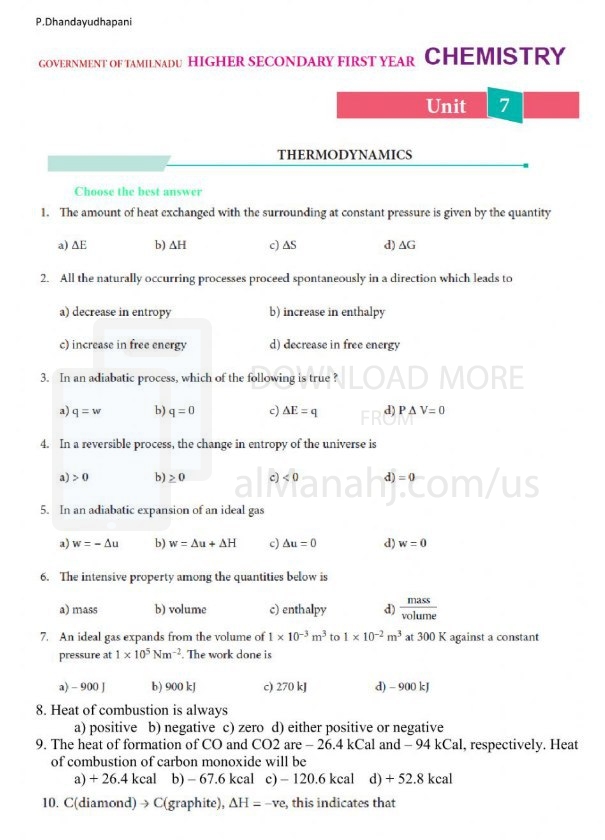| You are here: Almanahj Website ⇒ American curriculum ⇒ 11th Grade ⇒ Chemistry ⇒ Term 1 | ||
|---|---|---|
Worksheet about Thermodynamics | ||
|---|---|---|
| Subject: Chemistry | ||
| 11th Grade | ||
| Term 1 | ||
| Year: 2023/2024 | ||
| Size: 441.7KB | ||
| Number of clicks: 82 | ||
| Publish date:November 07, 2023 | ||
| Added by: Eman | ||
| Last download date: 2024-08-22 03:24:47 | ||
| Updated by: Eman9966 on 2023-11-07 07:35:55 | By: theodor P.Dhandayudhapani | |
| File info: Thermodynamics is a branch of chemistry that deals with the study of energy and its transformations in chemical systems. It provides a framework for understanding and predicting the behavior of substances and reactions based on the principles of energy conservation and the directionality of processes. Key Concepts in Thermodynamics:1. Energy: In thermodynamics, energy refers to the capacity to do work or transfer heat. It exists in various forms, including kinetic energy (energy of motion) and potential energy (energy stored in a system). The law of conservation of energy states that energy cannot be created or destroyed, only converted from one form to another. 2. System and Surroundings: A thermodynamic system refers to the portion of the universe under study, while the surroundings encompass everything outside the system. The exchange of energy and matter between the system and surroundings is a central focus in thermodynamics. 3. State Functions: Thermodynamic properties that depend only on the current state of a system, such as temperature (T), pressure (P), volume (V), and internal energy (U), are known as state functions. State functions are useful in describing and predicting the behavior of a system. 4. Laws of Thermodynamics: Thermodynamics is governed by four fundamental laws: a. First Law of Thermodynamics: Also known as the law of energy conservation, it states that the energy of a system remains constant unless acted upon by external forces. Mathematically, it can be expressed as ΔU = q + w, where ΔU represents the change in internal energy, q is the heat transferred to or from the system, and w is the work done on or by the system. b. Second Law of Thermodynamics: This law introduces the concept of entropy (S), which measures the degree of disorder or randomness in a system. It states that in any spontaneous process, the total entropy of the universe increases. It also defines the directionality of heat transfer, stating that heat naturally flows from a higher temperature region to a lower temperature region. c. Third Law of Thermodynamics: This law states that as the temperature of a system approaches absolute zero (0 Kelvin), the entropy of the system also approaches zero. It provides a reference point for entropy calculations. d. Zeroth Law of Thermodynamics: This law establishes the concept of thermal equilibrium. It states that if two systems are in thermal equilibrium with a third system, then they are in thermal equilibrium with each other. 5. Enthalpy and Entropy: Enthalpy (H) is a thermodynamic function that represents the heat flow in a system at constant pressure. It is often used to measure the heat absorbed or released during a chemical reaction. Entropy (S) quantifies the randomness or disorder of a system. It plays a crucial role in determining the spontaneity of a process. 6. Gibbs Free Energy: Gibbs free energy (G) combines the effects of enthalpy and entropy to determine the spontaneity of a chemical reaction. A negative ΔG indicates a spontaneous reaction, while a positive ΔG indicates a non-spontaneous reaction. Applications of Thermodynamics in Chemistry: Thermodynamics plays a vital role in various areas of chemistry, including: - Determining the feasibility and spontaneity of chemical reactions. - Predicting the equilibrium positions and conditions of reactions. - Understanding and optimizing industrial processes, such as chemical synthesis and energy production. - Investigating phase changes, such as vaporization, condensation, and melting. - Analyzing the thermodynamic stability of compounds and materials. Overall, thermodynamics provides a fundamental framework for understanding energy transformations and predicting the behavior of chemical systems. It enables chemists to study and manipulate energy changes in a wide range of chemical processes and applications. | ||
| Downloading link Worksheet about Thermodynamics |
|---|
|
1699342490.pdf
The file is being prepared for download
|
| File images |
|---|
 |